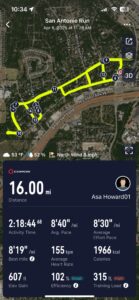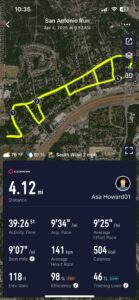Week 4 – Don’t Heat Around the Bush
Asa H -
This week started off on the not the greatest of feet, but has turned out pretty well. Last week, I pushed my long run back by a day because I was feeling pretty crappy after getting a few shots. So, instead of starting off the week with a rest day, instead I was out finishing last week’s long run. Long story short, it didn’t go the best it could have. Monday had a high of 89 degrees and what with me opting to run later in the day, I felt the full force of that. Had I run earlier in the day, the heat likely would’ve been a nonissue, but it was at least a valuable lesson. The closer it gets to summer the more important it’s going to be to knock my runs out early if I want them to be anything but sluggish. I ended up ending the long run early because I was feeling pretty gross. I think that mostly came down to me getting in my own head, but the heat and humidity didn’t help. It’s only going to get hotter in the coming weeks, so I think now’s a great time to talk about issues that come up when running in hot weather. The two big ones I want to talk about are Heat Exhaustion and Heatstroke. I’d bet most other people who live anywhere hot have heard these two terms thrown around and often they’re used interchangeably. However, these two conditions present very different levels of danger.
Heat Exhaustion is fatigue associated with the heat. A great example is if you’ve ever been outside all day and started to feel drained. A big chunk of that fatigue likely comes from being heat exhausted. Symptoms of heat exhaustion can include: dizziness, headache, nausea, weakness, unsteady gait, muscle cramps, and fatigue. When somebody is heat exhausted, their body temperature is elevated, but stays below 104 degrees Fahrenheit. The best way to deal with heat exhaustion is to go cool off. Drinking cold fluids can help, but getting out of the sun is best. Heat exhaustion by itself is not very dangerous and usually can be easily resolved. However, Heat Exhaustion can progress to Heatstroke. This change happens when the person’s body temperature passes the 104 degree mark. Symptoms of Heatstroke include: a change in mental status, such as confusion, delirium, combativeness, seizures, loss of consciousness. What makes Heatstroke so much more dangerous than Heat Exhaustion is that because your body temperature is so elevated, your brain is cooking. That’s the reason for the change in mental status, which presents in Heatstroke patients. People experiencing Heatstroke need to be cooled, but also it’s important to call 911 because if they’re not given the proper drugs, their body temperature will continue to climb and they will die. Given how hot it gets in Texas, all races prepare for assisting runners who are experiencing Heat Exhaustion of Stroke.
Since my lackluster run on Monday, the rest of the week has been great. I got in some nice easy runs. I’ll attach some of the training data below. And I was able to finish off the week with a strong long run. The weather was a lot nicer, but I also made sure to knock it out earlier in the day, so I didn’t have to test my luck with the heat.




Comments:
All viewpoints are welcome but profane, threatening, disrespectful, or harassing comments will not be tolerated and are subject to moderation up to, and including, full deletion.